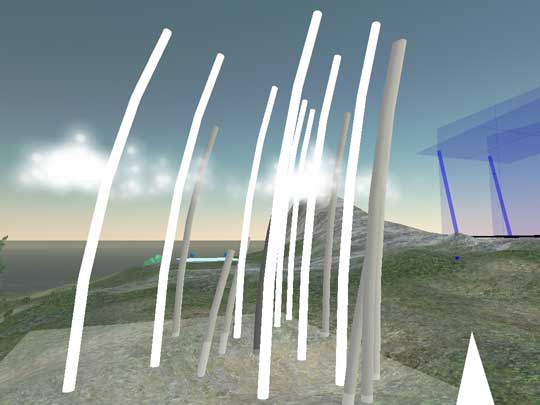Moaning Columns of Longing
Unsung Song #7

Moaning Columns of Longing was an interactive audiovisual sculpture, part of a suite called Seventeen Unsung Songs, by Adam Nash, which was shortlisted for the National Art Award in New Media at the Queensland Gallery of Modern Art in 2009.
VIDEO
This video is a short documentary of the work by the KQED channel, USA
(note, 'Adam Ramona' was my avatar name in Second Life).
ARTIST STATEMENT
The Moaning Columns of Longing explicitly explores the nature of our emotional reaction to virtual experience. Staged in the realtime 3D environment Second Life, the work enacts emotional and sensual blackmail. In doing so, it consciously exploits the user’s understanding of the spatial and material analogies used to interface with the environment. This creates a technically mediated experience of emotion/affect that is aware of its own excess. When a user’s avatar approaches the work, a virtual ‘column’ is spawned, glowing white and spurting glittering particles of joy while it declares its undying, faithful love for the user via the ‘chat’ facility built into the interface.
Once the user leaves the space (that is, logs out), the column starts sending more and more emotionally manipulative emails begging the user to return. Every hour that the user does not return to ‘touch’ the column (‘touch’ is the Second Life interface analogy used instead of ‘mouse click’), the column becomes a little duller, a little shorter, and starts emitting a moaning sound that becomes louder as the hours pass. The hourly emails become more desperate and more emotionally demanding (“without you, I will die”). If the user does not return within 24 hours, the column will ‘die’, that is, in technical terms it will be deleted from the database permanently. If the user does return to ‘touch’ the column within 24 hours, the column returns to its full height, glowing brightly and rejoicing loudly over the chat channels, “[username] loves me! My existence has meaning!”
Over the couple of years this work was in operation, some users maintained their columns for months at a time. During this time, these users returned to their column at least once every 24 hours, and received an email from their column every single hour for the entire time their column was ‘alive’. This nuanced composition of technologically mediated emotional exchange between the virtual and material calls into question the instrumentality of not only the technological interaction itself, but also the very means by which such an interaction can take place and the affective relationship between love and technology. It also amply illustrates the process of modulation from data-as-data to data-as-display and the complicity of the user in such a modulation.
Until the user activates the work (both technically by logging in and conceptually by accepting the display parameters such as ‘touch’, ‘visit’, ‘love,’ etc), it is nothing more than a set of undifferentiated, plastic, digital data. Upon activation, the data-as-data is modulated, via a computational parameter framework, into data-as-display (sound, vision, words, emotions), the only mode by which it is really possible for a person to interact with the work.